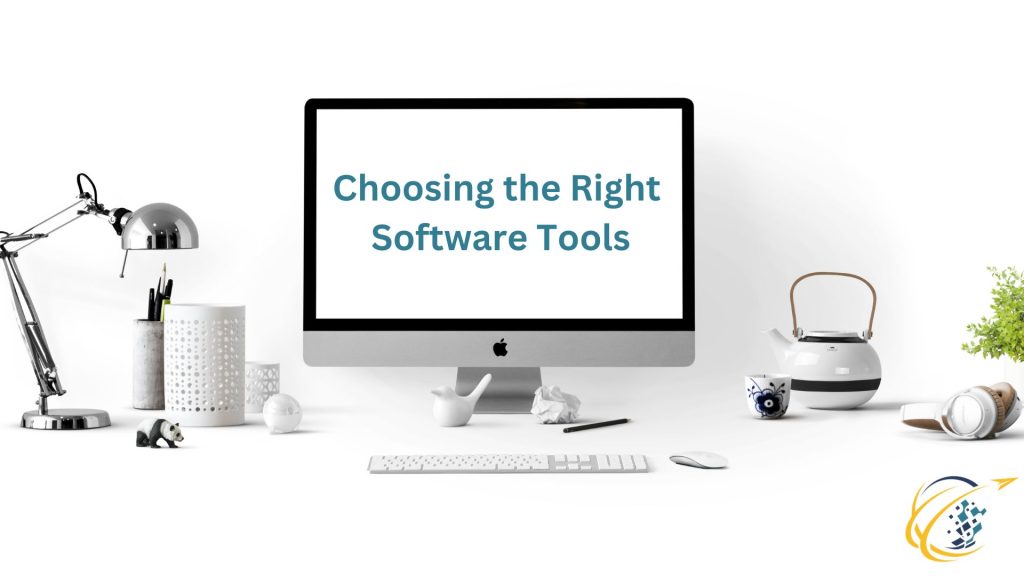Choosing the right software tools is crucial for any business aiming to boost operational efficiency and competitive edge. With many options available, it’s important to strategically consider both immediate needs and long-term growth. This involves evaluating the specific requirements of the business, exploring various software types. It’s also important to understand their impact on productivity and financial performance. Below, we’ll discuss key considerations for selecting effective software tools, including integration capabilities, scalability, and return on investment. This ensures businesses make informed, cost-effective decisions that support their goals and drive success.
Assessing Business Needs
Assessing business needs is a critical initial step in choosing the right software tools. This evaluation ensures that the selected tools will effectively address the specific challenges and requirements of your business, enhancing productivity and efficiency. Businesses must analyze their current operations to identify areas ripe for improvement through automation or optimization.
Firstly, identify key processes that are cumbersome, time-consuming, or error-prone. These are prime candidates for automation. Common areas often include data entry, inventory management, and customer relationship management. Automating these processes can reduce human error, save time, and free up resources for more strategic tasks.
Secondly, consider the necessary workflow integrations across different departments. Understanding how various teams interact and depend on each other will help select software that enhances collaboration and data sharing. This capability is crucial for maintaining an efficient workflow and ensuring all business parts can communicate effectively without silos.
Furthermore, involve stakeholders from various parts of the organization during the assessment phase. Their insights will help pinpoint the specific features needed in the software to address daily challenges. This inclusive approach ensures the selected tools are practical and aids in smoother adoption and implementation.
Lastly, prioritizing these needs based on their potential impact on business operations is essential. This helps make informed decisions when faced with budget constraints and guides deployment phases, ensuring the most critical needs are addressed first.
By methodically assessing business needs, companies can make informed decisions when choosing the right software tools, ensuring that their investment contributes directly to operational improvements and business growth.
Software Types and Their Uses
In choosing the right software tools, it’s essential to understand the variety of options available and their support for different business functions. This knowledge helps select software that aligns with specific business needs and enhances operational efficiency across departments.
For example, project management software like Asana and Trello helps teams organize, track, and manage tasks effectively. Users can create tasks, assign them, set deadlines, and monitor progress on a single platform. This software is crucial for maintaining transparency, ensuring accountability, and keeping projects on schedule.
Customer Relationship Management (CRM) software, such as Salesforce or HubSpot, manages interactions with current and potential customers. These tools are vital for businesses aiming to boost customer satisfaction and loyalty. CRM systems store data about customer interactions, purchases, and preferences, useful for tailoring marketing efforts and enhancing service.
Accounting software like QuickBooks and Xero is essential for managing financial data. These tools help track revenues and expenses, process payroll, and generate reports crucial for financial planning and auditing. By automating complex accounting tasks, they reduce errors and free up time for financial analysis and decision-making.
Each software type serves distinct functions crucial for smooth business operations and growth. When choosing software tools, consider not only immediate needs but also potential for scalability and integration with other systems. Understanding the benefits of each software category guides businesses in making informed decisions that support their operational goals.
Integration Capabilities
When choosing the right software tools, consider their integration capabilities. Seamless integration is crucial for maintaining efficient data flow and enhancing productivity. Well-integrated software minimizes disruptions and facilitates smoother transitions during implementation.
Integration capabilities allow different software tools to communicate effectively, sharing data in real-time and reducing manual data entry. For example, integrating CRM software with email marketing tools automates the update of customer information across platforms. This ensures that marketing campaigns are targeted and based on the latest customer data, saving time and increasing marketing effectiveness.
Additionally, good integration supports data analytics consolidation, providing a holistic view of business operations. This comprehensive perspective is vital for strategic decision-making, allowing leaders to draw insights across various functions, from sales and marketing to finance and operations. For instance, integrating sales data with financial software can quickly provide insights into cash flow and revenue trends, enabling agile financial planning.
Software with strong integration capabilities can also adapt more easily to an evolving technological landscape. As businesses grow and needs change, the ability to integrate new tools or upgrade existing ones without extensive modifications is incredibly beneficial. This flexibility can significantly reduce long-term IT costs and prevent logistical challenges associated with replacing incompatible systems.
Integration capabilities are not just a technical necessity but a strategic asset in choosing the right software tools. They ensure smoother operations, enhance data-driven decision-making, and provide flexibility for future growth, making them indispensable for businesses aiming to optimize their technological investments.
Scalability and Flexibility
Choosing the right software tools for your business means considering their scalability and flexibility. These tools must grow and adapt with your business, meeting increased demands or strategy changes without compromising operational efficiency.
Scalability in software means it can handle increased workloads or expand in size. For example, as a business grows, it might need to process more transactions, handle larger data sets, or support more users. Scalable software prevents performance bottlenecks and supports business growth without being limited by technical constraints.
Flexibility is just as crucial. It refers to the software’s ability to adapt to changes in business processes or objectives. This could mean adding new functions, integrating with other tools, or modifying features to align with new business strategies. Flexible software lets businesses pivot easily and respond to market changes without costly and disruptive overhauls.
Moreover, both scalability and flexibility are vital for ensuring long-term viability of software investments. Choosing software that meets only current needs but lacks growth potential can lead to challenges. It might necessitate premature system replacement or force a business to adjust its operations to the software’s limitations, affecting efficiency and growth.
When selecting software tools, businesses should evaluate not only their current needs but also future requirements. Investing in scalable and flexible software solutions allows growing businesses to thrive without being constrained by their tech infrastructure. This foresight in software selection is key to maintaining a competitive edge and operational excellence over time.
Costs and ROI
When choosing the right software tools, understanding the financial implications is crucial for making informed, cost-effective decisions. This includes considering the initial costs, ongoing subscription fees, and, most importantly, the potential return on investment (ROI) that the software provides.
Initial costs of software can vary significantly depending on whether the solution is on-premise or cloud-based. On-premise solutions often require a substantial upfront investment in hardware and software licenses, while cloud-based tools might be accessible via a subscription model with lower initial costs. This makes cloud solutions particularly attractive for small to medium-sized businesses due to their lower entry barriers and reduced need for in-house IT infrastructure.
Subscription fees are another critical factor. Many software tools require ongoing payments that cover usage, updates, and support. While this can mean predictable operational expenses, it’s important to evaluate these costs over the long term. Companies should compare different pricing models and consider how these fees fit into their overall budget, ensuring that the ongoing costs are manageable and justified by the benefits the software provides.
The potential ROI of software tools should be the deciding factor. Effective software solutions should streamline operations, reduce labor costs, or increase sales enough to justify their cost. Businesses should assess how the features of the software align with strategic goals, potentially boosting productivity, improving customer satisfaction, or enhancing data-driven decision-making. Estimating the ROI involves looking at the measurable improvements the software can bring against its cost over a defined period.
Conclusion
In conclusion, selecting the right software tools significantly impacts a business’ operational efficiency, scalability, and financial health. By assessing business needs, understanding available software types, and considering integration capabilities, scalability, and financial implications, businesses can make informed choices. Each element, from initial costs and subscription fees to the software’s growth potential with the company, plays a crucial role in this process. Ultimately, the right software tools streamline operations, enhance productivity, and drive better business outcomes. This provides a competitive edge in today’s fast-paced market. Carefully selecting software ensures technology investments yield substantial returns, supporting sustainable growth and long-term success.



